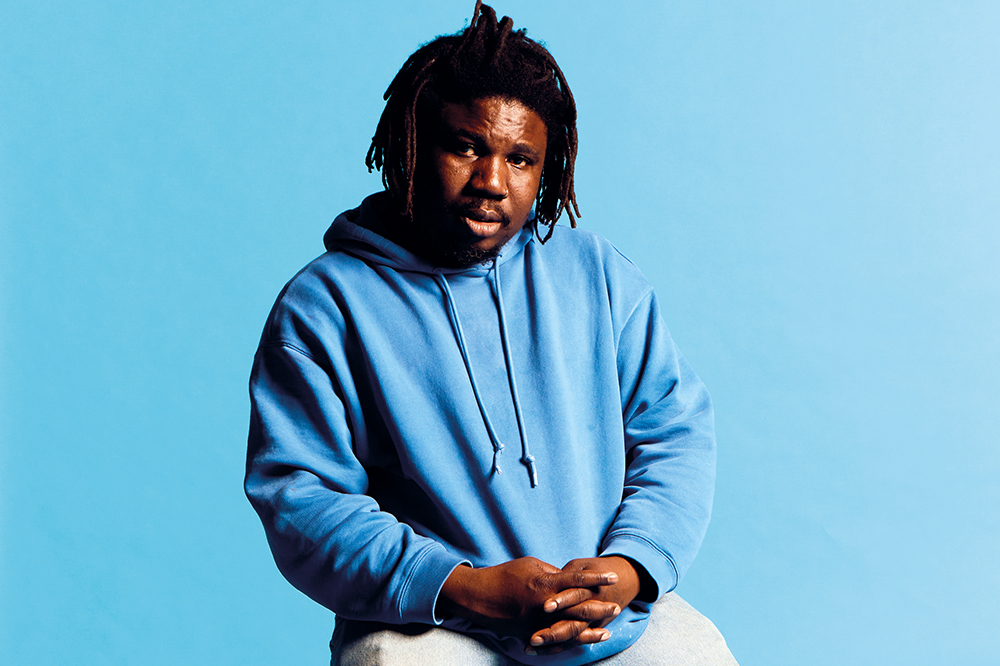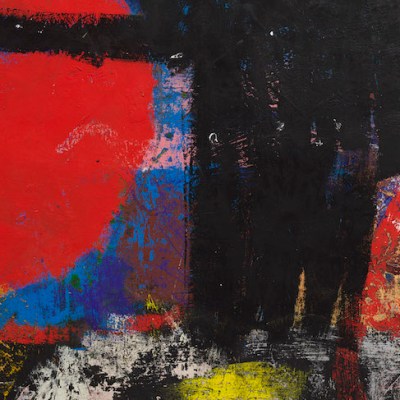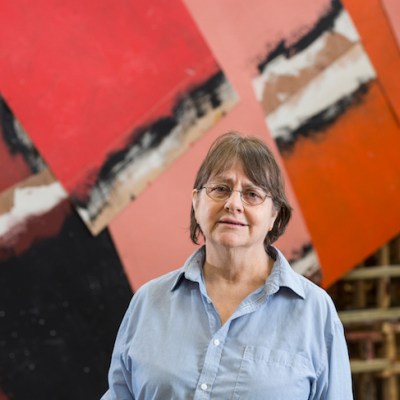From the May 2024 issue of Apollo. Preview and subscribe here.
Alvaro Barrington hasn’t slept much. His gallery assistant, Natalia Grabowska, warns me of this as she’s showing me around his studio. ‘He’s a bit sleep-deprived today,’ she says. ‘He goes into beast mode, where he likes to sleep here and work for hours and hours – it’s never-ending.’ When, half an hour later, Barrington welcomes me into his office at the top of his studio building, I see what Grabowska means. He’s wearing a sweatshirt, jogging bottoms and rubber loafers in the shape of frogs. ‘The past week I’ve been here and that has been my bed,’ he tells me, pointing to the brown leather sofa behind me, which is piled high with unidentified fabrics. He sits on an office chair next to his computer, a window behind him looking out on the studio garden and a work in progress leaning against the wall: a canvas of about a metre square, covered in little patches of brown and green yarn that he says is inspired by the colours in his garden. I ask him why he’s been sleeping in his studio when he lives just down the road. ‘If I could be in my studio 24/7 I would,’ he says. He looks deadly serious.
Tupac Bather, Oct 2023 (2023; detail), Alvaro Barrington. Photo: Charles Duprat; courtesy Thaddaeus Ropac gallery, London, Paris, Salzburg, Seoul; © the artist
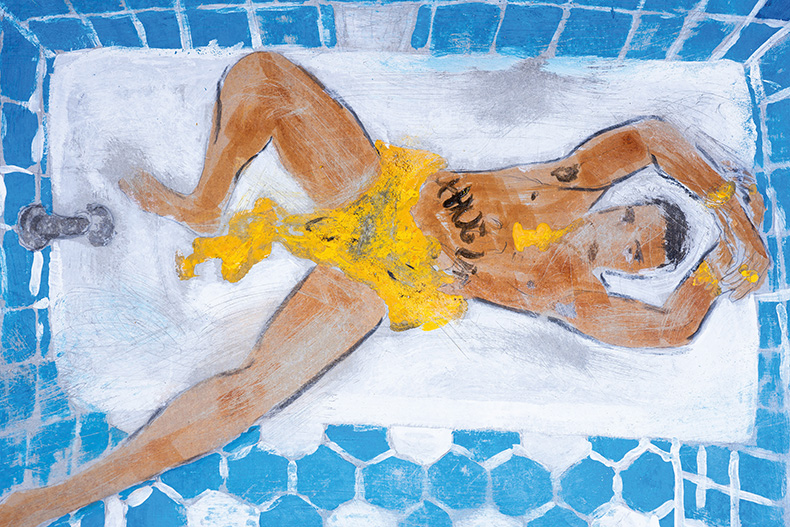
By the end of the interview I feel that, if I were given a proper bed, I too wouldn’t mind spending most of my time here. Barrington is a gracious host – intelligent, polite, intense at times but funny too – and his studio, a sprawling affair that takes up two buildings of a decommissioned school on Whitechapel Road, is an awe-inspiring place, full of vitality and chaos. I count eight people in total while I’m there, including three in his woodwork studio, affixing corrugated iron sheets and sawn milk crates to wooden slabs to create the cobbled-together frames he uses in his works, and three helpers ironing fabric in his sewing studio, where endless scrolls of yarn and hessian are filed away like manuscripts on wall-to-ceiling shelves. I walk into his painting studio and am greeted not by a human but by a life-sized painted cardboard figure of the late, great basketball player Kobe Bryant. It’s all thrillingly hectic and feels like a suitable place of origin for Barrington’s artworks, which range from vibrant paintings to Rauschenberg-esque assemblages of traditional and unorthodox materials – paint, concrete, yarn, hessian, glass, neon lights, milk crates, snare drums, brooms – and are inspired by everyone from Cy Twombly to Tupac.
Barrington’s upcoming commission for Tate Britain, which opens at the end of May, marks the latest step in what has been a remarkable and rapid rise to art-world stardom. Born in Venezuela in 1983 to Haitian and Grenadian parents, and raised by relatives between Grenada and New York, Barrington says that he always knew, on some level, that he wanted to be an artist. ‘I never considered art in the way that we think of it in the art world until much later, but 30 years ago I was a kid in my neighbourhood customising people’s clothes […] people would come to me because they got a pair of sneakers and they wanted them to look different […] I think that was art.’ The first point in his formal artistic education came at Hunter College in Manhattan, a ‘gladiator-style’ art school, he remarks, where professors such as Nari Ward and Daniel Bozhkov would posit their ‘extremely strong opinions about what art is, and I got to listen to all these different voices and pick and choose what I would go along with’.
1953-2017 (2017), Alvaro Barrington. Photo: Stephen James; courtesy the artist and Emalin, London; © the artist
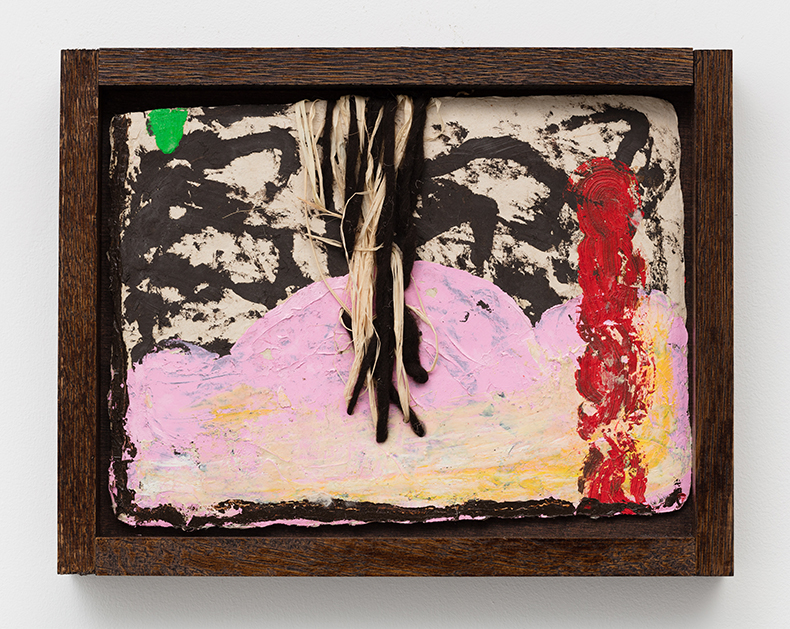
After Hunter, Barrington moved to London and enrolled at the Slade, from which he graduated in 2017 – the year he had his first solo exhibition in New York, at MoMA PS1. At the Slade, the lack of class structure suited him: he spent time using what little money he had to book coach trips around European cities to see exhibitions. ‘I went to everything, everywhere’ and ‘If an artist spoke about it, if an artwork hinted at something else, I just thought, “Okay, let me go down this rabbit hole.”’ His voraciousness and ambition haven’t faded; Barrington did six shows last year in preparation for the Tate exhibition, on top of designing floats for Notting Hill Carnival and Glastonbury. ‘When I was offered the commission I called up all the galleries and I said, “Can you schedule me in?” It let me get further with my ideas than I would have done had I just done the traditional two shows a year.’ It became ‘an addiction’, says Barrington. ‘I’m very nervous for the post-Tate crash.’
What exactly the exhibition will entail is still under wraps when we meet, but Barrington says that he went to Rome and Florence in preparation, visiting old churches and looking at Caravaggios to reconnect with the historicity and collaborative aspects of painting. He hints that painting will play a part in the show, too. ‘I feel like painting has dealt with a lot of the pressures of PDF culture,’ he says, ‘like music, which used to be an experiential thing […] a ritual, and now it’s just a playlist.’ Not a revolutionary observation, perhaps, but the three-dimensionality of art, the idea that it needs to be seen in person, is borne out in Barrington’s work – most clearly in pieces such as Street dreams are made of basketball (2021), in which a yarn-covered canvas is adorned with a basketball embedded in concrete, a plastic tray and hanging chain, and a concrete ledge jutting out towards the viewer. But it is also there to a more subtle degree in his paintings – 1953–2017 (2017), for example, in which a shock of black and white yarn hangs over an abstract canvas of black, pink and red oil strokes; it would be easy, looking at the work on a computer screen, to miss that twist of thread. Barrington describes himself as being ‘very attracted’ to the physicality of art, citing the feeling of going to see a work and finding it to be much bigger or smaller than you initially thought it was. The American painter Laura Owens has spoken about this in an interview that he says he has watched hundreds of times.
Street dreams are made of basketball (2021), Alvaro Barrington. Photo: Stephen James; courtesy the artist and Emalin, London; © the artist
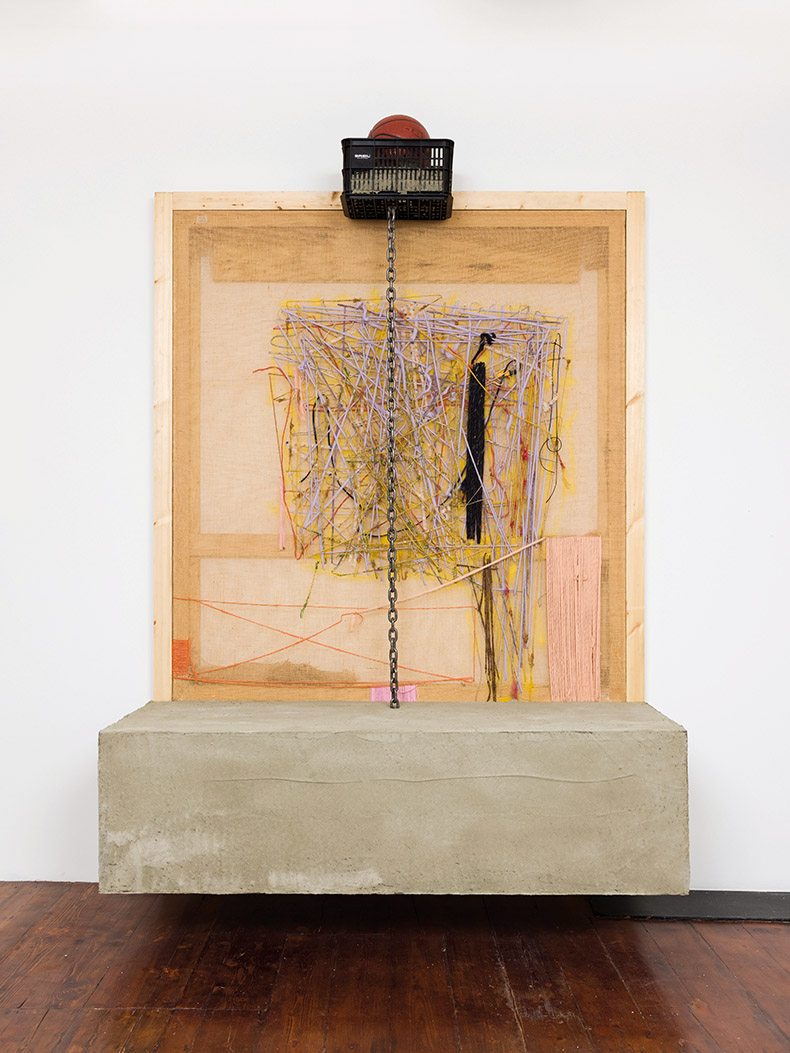
Owens crops up repeatedly as we are talking, but hers is one name among many. All artists take inspiration from others, but Barrington is unusually, disarmingly upfront about it. In 2019 he co-curated an exhibition at Thaddaeus Ropac with the gallery’s senior global director, Julia Peyton-Jones, titled ‘Artists I Steal From’, a show which featured one piece by Barrington alongside the work of 40 artists whom he cited as direct influences. ‘I think it felt unusual because in contemporary culture artists are believed to be fully formed,’ he says, ‘and that wasn’t necessarily what I was.’ His own work, a mixed-media canvas, Unc you the plug (2019), underscored the show’s title by incorporating into its frenetic central square of yarn strands an orange cable that Barrington plundered when he went to visit the Rauschenberg Estate in Captiva, Florida. The work was exhibited with a list of ‘who and what I’ve directly stolen from’ to make the work, which included Matisse’s cut-outs, Rashid Johnson’s series Anxious Men (2015) and 1990s hip-hop fashion. Among the works selected by Barrington for the exhibition were some Abstract Expressionist canvases by Willem de Kooning and Louise Fishman, a Basquiat self-portrait from 1983, a hanging sculpture by Louise Bourgeois, Janus in Leather Jacket (1968), and several paintings by his peers and friends, including Owens and the abstract painter Joe Bradley.
The Fishman work in particular epitomises the complexity of Barrington’s network of influence. It’s a gorgeous painting (though I feel I have failed Barrington by only ever having seen it on my computer screen): bold, frantic but somehow softer and more appealing – to me at least – than most de Koonings or Pollocks. It’s called Mondrian’s Grave (2018) and it shares a certain boxiness with Mondrian’s modest, squat headstone in Cypress Hills Cemetery, Brooklyn – a quality that is also present in some of the Dutchman’s most famous works, particularly the painting Broadway Boogie Woogie (1942–43). Barrington repurposed the colours and shapes of the Mondrian in the stained-glass milk-crate frame for The Garden of Dreams, 90s Bulls (L), Oct 2023 (2023), a stunning assemblage that was exhibited in his show ‘They Got Time: You Belong to the City’ at Thaddaeus Ropac in Paris last year, the centrepiece of which is a concrete slab painted with a floral motif and two basketball players. He has referred to Broadway Boogie Woogie before and he brings it up with me, citing it as a work that ‘came from the city’. So, when Barrington talks about Fishman’s work, he’s also implicitly talking about Mondrian, New York City, Abstract Expressionism, Bosch’s The Garden of Earthly Delights (another direct influence on the work) and a whole personal canon of art and culture that, it seems, feels as natural to him as putting paint on a canvas. In an interview Barrington gave around the time of ‘Artists I Steal From’, he was asked about the anxiety of influence – a question he brushed away. The more time I spend with him, the more it becomes clear to me that not only does Barrington not suffer from that anxiety, but he is almost incapable of it, because he seems unmovably certain about the way he goes about making art. The assemblage-like quality of his work reflects his world view, in which everything – people, art, history – is collaborative and co-dependent.
The Garden of Dreams, 90s Bulls (L), Oct 2023 (2023; detail), Alvaro Barrington. Photo: Charles Duprat; courtesy Thaddaeus Ropac gallery, London, Paris, Salzburg, Seoul; © the artist
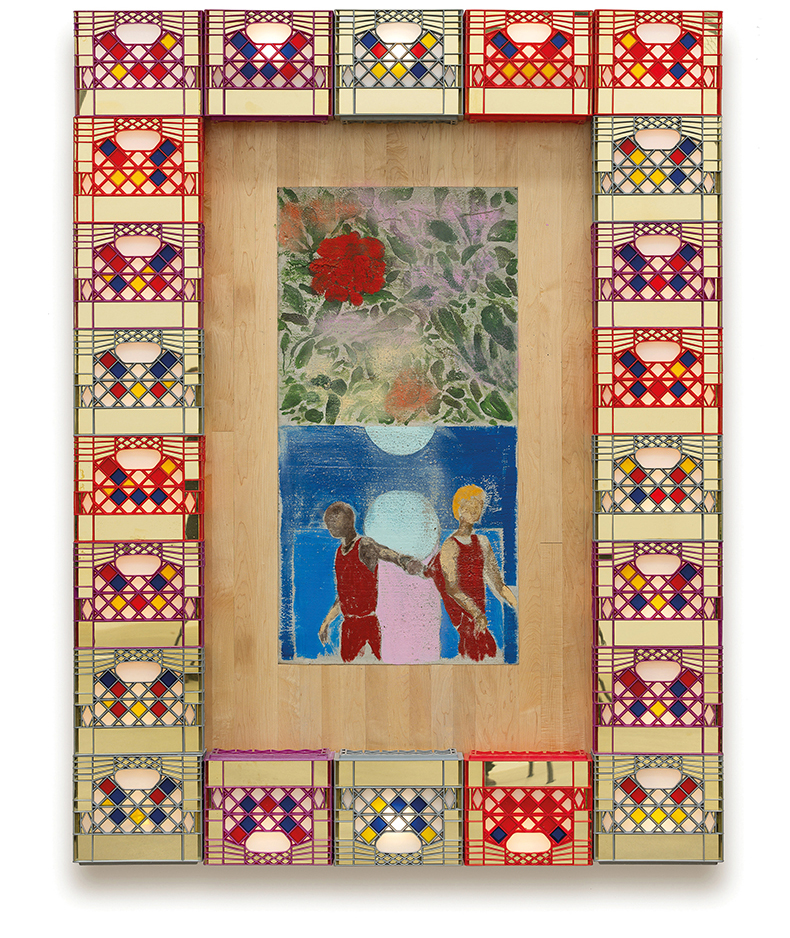
Why does he think that is? ‘This is one of the lessons I got from hip hop,’ he tells me. ‘You have artists like Tupac influencing Dr Dre, who’s working with whoever on a song, and that song is sampling Marvin Gaye and so on, so I began thinking about paintings as legacies of other artists.’ It makes sense, but is there not a danger, with this approach, that everything, even plagiarism, becomes fair game? ‘I spent my undergrad copying every fucking artist, whether I hated them or loved them, but I knew ultimately that somehow it had to be my version of the art,’ he replies. When he was at art school, ‘a lot of kids were making nature paintings, but they grew up in the city […] I think because Peter Doig was really big and people were making Doig paintings without saying so […] and that didn’t feel interesting to me.’ For Barrington, art has to start from a place of authentic experience.
It was hip hop culture that taught him the importance of paying homage, acknowledging your sources and doing something new with them; those who didn’t were looked down upon as ‘biting’ other rappers. Here, Barrington becomes more animated. ‘When I was at art school, Joe Bradley was killing it in Canada, and all these artists started making Joe Bradley paintings, and every one of them pretended that they didn’t go to Joe’s show. They would just be like ‘“Huh, I just made this”’ (his voice ascends half an octave), ‘And I was like, “I saw you at Joe’s show!”’ Now he is leaning forward, almost shouting. ‘“I saw how you were painting on Monday, I saw you at Joe’s show on Tuesday, and it’s Friday, and your work has changed.” But they would act like that wasn’t even a thing […] They copied this other artist and then felt like they invented and accomplished something […] I thought it was very disingenuous, very ego-driven.’
The Garden King of Spades Eddie (Y), Oct 2023 (2023), Alvaro Barrington. Photo: Charles Duprat; courtesy Thaddaeus Ropac gallery, London, Paris, Salzburg, Seoul; © the artist
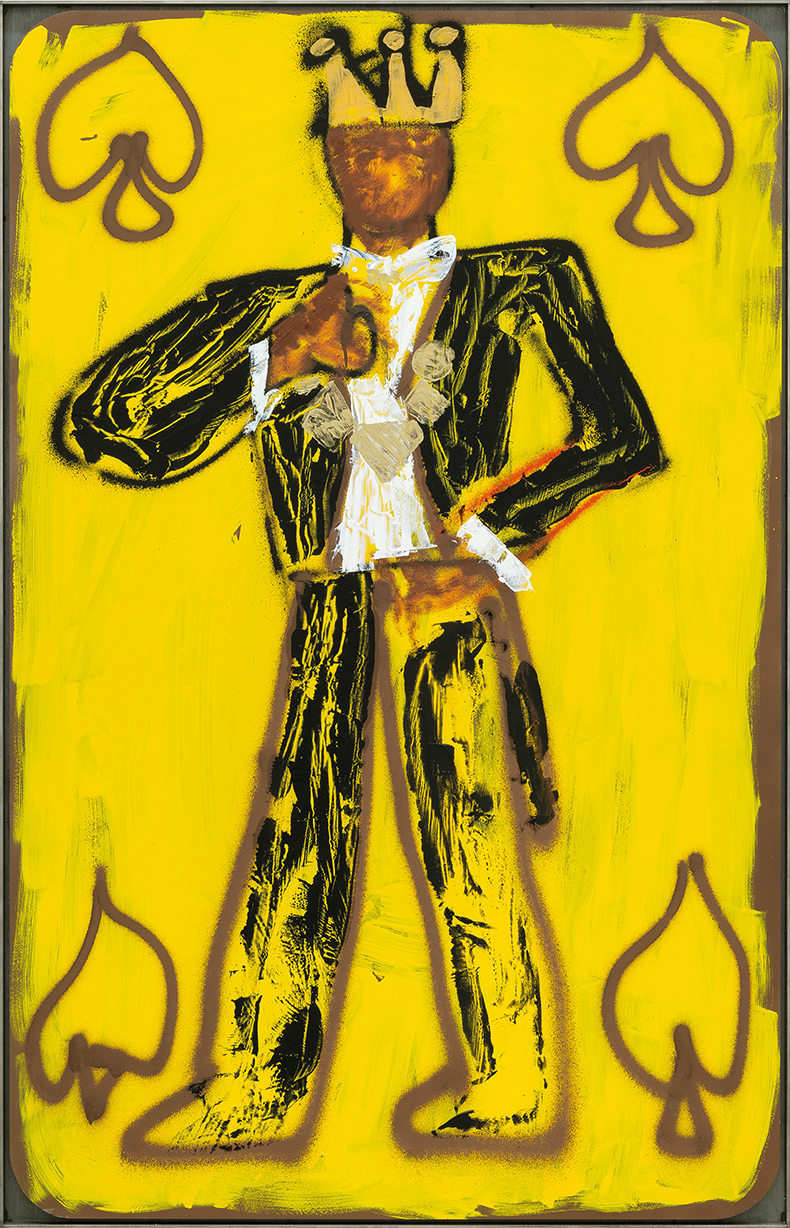
Of all the influences that Barrington cites, there is one who towers above all. Tupac Shakur comes up repeatedly in Barrington’s art – in the work They have They Cant (2021), which features stitched lyrics from the song ‘Keep Ya Head Up’ and a string of bandanas; and in Tupac Bather, Oct 2023 (2023), a painted interpretation of David LaChapelle’s famous bird’s-eyeview photograph of the rapper lying in an empty bath, clad in Y-fronts made from a jumble of gold chains. The video for ‘Keep Ya Head Up’ opens with a dedication to Latasha Harlins, a 15-year-old Black girl who was shot dead by Soon Ja Du, a Korean-American convenience store owner, in Los Angeles in 1991. Barrington tells me the whole story movingly, referring to the judge’s comments at the trial – in which Du was convicted of voluntary manslaughter – about Du’s actions being ‘understandable’. ‘It took art, it took Tupac, to make the community feel okay,’ says Barrington. ‘Art saved my life […] and I know women who have Tupac tattoos on their breasts today because of “Keep Ya Head Up”. I saw the reaction as a communal way of dealing with disadvantage.’ He is highly aware of how his background feeds into his many different preoccupations, belonging as he does to a ‘very academic tradition of art’, as well growing up as a ‘working-class immigrant’ in the midst of ‘carnival culture’. Barrington’s dedication to community is apparent in his work with Notting Hill Carnival and Glastonbury, and in the children’s basketball court he designed in Bethnal Green, just a stone’s throw from his studio. His plans for the renovation of his studio include a community centre and kitchen in the back building. ‘My art’s got to be in the community, it’s got to be a carnival, I’m there with you,’ he says excitedly.
Alvaro Barrington photographed by Jeremiah Cumberbatch in April 2024
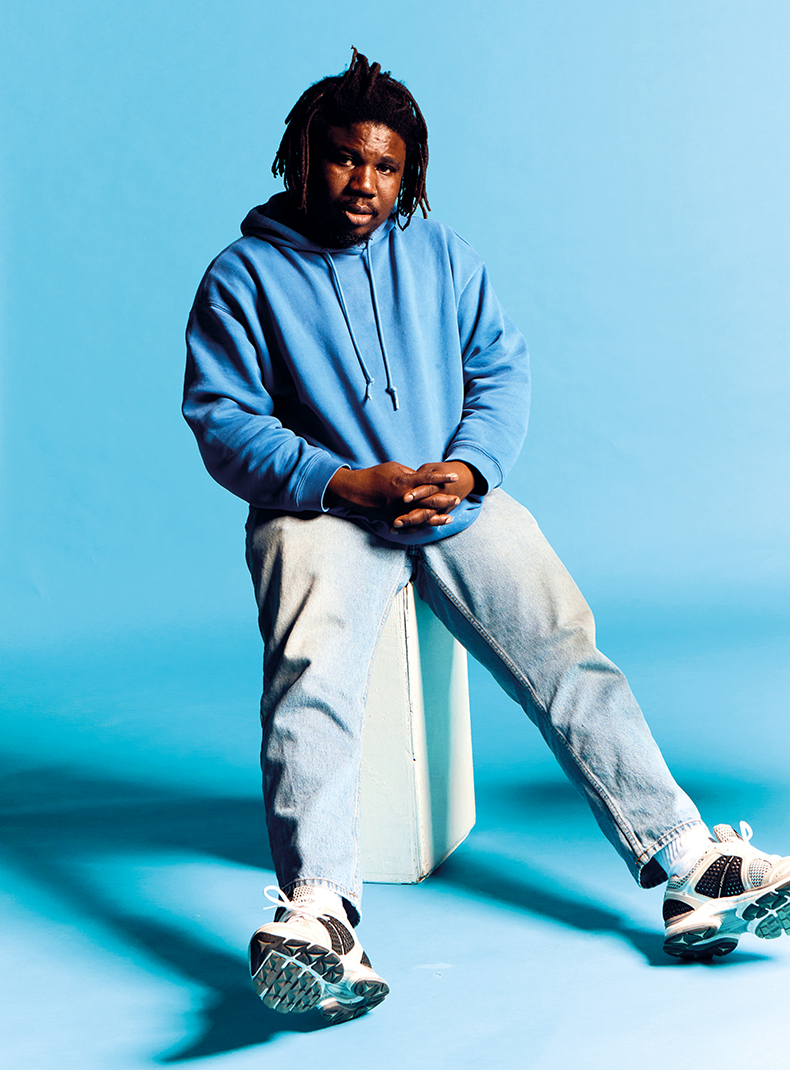
Many artists intone about community and social justice. Few do it while making art as well thought-out, original and seductive as he does. As things are drawing to a close, I ask him if he has a favourite work of his. ‘Yeah, this one,’ he smiles, pointing to the unfinished garden scene propped against the wall. ‘It’s always the work in front of me, or the next work.’ I could be inclined to roll my eyes, but by this point I think I believe him. Barrington’s casual, amicable manner belies his relentless ambition, his determination to become a ‘great artist’. The run-up to a big show is, for him, ‘where the high comes in’. I doubt it will be long before everyone else gets hooked too.
From the May 2024 issue of Apollo. Preview and subscribe here.
